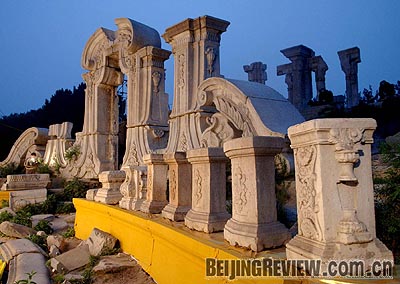|
Westerners as the Summer Palace. The park was mainly composed of a hill, named Wanshou Hill, and a lake, named Kunming Lake and was the place where the royal family of the time would escape the summer heat. The area of water accounts for three quarters of the garden. There are more than 3,000 ancient buildings inside the garden. The well-known Fo Xiang Ge (Imperial Residence of Buddha Fragrance) is the heart of the old buildings, which is located on the hill and faces water. The lake is spanned by a long bridge with 17 arches resembling a rainbow.
Yuanming Yuan Park

Also situated in the western suburb of Beijing, the Yuanming Yuan was built as an imperial park of the Qing Dynasty. Covering some 3.5 million square meters, the Yuanming Yuan includes three smaller gardens. The park represents all the features and characteristics of garden architecture and design art in old China. In the past, the royal park housed numerous treasures, which included valuable calligraphic and painting works, historical documents and artworks and jewelry. But, unfortunately, the park was mercilessly sacked by the British and French armies in 1860 and by the Eight-Power Allied Forces in 1900 respectively. Buildings in the park were destroyed by fire and priceless treasures were plundered. The beautiful royal park now lies in ruins. Today, visitors can still feel the tragic events of history in the remains of buildings left behind.
The Beihai Park
Located in the northwest of the Forbidden City, the Beihai Park was one of the largest imperial parks in China with a long history. It is said that the park is also an imperial garden that has the longest history in the world. Dating back to the 10th century, the park used to be the royal garden of five dynasties in China's history, which included the Liao, Jin, Yuan, Ming and Qing dynasties. A small island, named Qionghua Island, sits in the center of the park's lake, which was the most attractive site there. A screen wall carved with nine Chinese dragons is located on the north bank of the lake, which is one of the three ancient nine-dragon screen walls in China. A special treat for those who wish to try imperial food, is the Fangshan Restaurant. The menu of the restaurant is made up of court dishes eaten by the royal families in the Qing Dynasty.
Temple of Heaven
Located in southeast Beijing, the Temple of Heaven covers an area of 2.7 million square meters and is the largest ancient building group for royal sacrificial ceremonies. A platform for emperors to perform solemn rites to pray to the Heaven for bumper harvests, the temple was initially completed in 1420 (the Ming Dynasty) and was later repaired and rebuilt in the Qing Dynasty. Affected by the ancient Chinese religious belief that the Heaven is round and the Earth is square, the buildings in the temple are constructed on a central axis, with the main buildings of the temple round and their bases square. Based on the same belief, the northern part of the park is in a semicircular shape and the southern part is a square. In the south of the temple complex are the Altar of Heaven and the well-known Echo Wall.
Ditan Park
Ditan, also named Fangze Tan (square water altar), is the second largest of the five ancient altars in Beijing. Constructed in 1530 during the Ming
|
